Among the main challenges are interference mitigation in the service uplink on a miniaturized platform. Additionally, compensating for the vast distance and relative speed to ensure compatibility with standard cellular and IoT technologies and devices on Earth.
Project Features
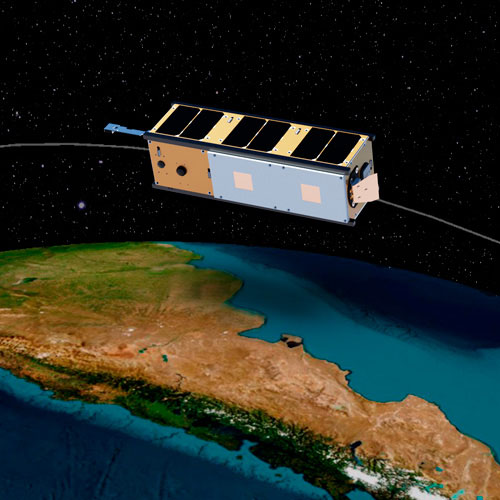
The satellite will be launched in 2025 via a SpaceX Falcon 9 rocket into a sun-synchronous orbit, with signal coverage passing over each location on Earth between 2 to 4 times per day, except near the poles where it will pass 15 times per day. The satellite is equipped to handle multiple technologies, communication standards, their variants, and future versions of these standards. It can operate within the band assigned by the ITU and 3GPP for direct satellite-to-cellular communication in the S band (around 2GHz), and also handle other technologies in unlicensed bands in the 900MHz range, as well as the S telemetry band.
Its electronics are reconfigurable to support new schemes for modulation, synchronization, beamforming, MIMO, and new algorithms and protocols. It can function as a base station in coordination with terrestrial networks when passing areas visible to ground stations. Additionally, it can provide independent service even while on orbit sections where no ground stations are visible.
This flexibility allows it to host technologies and developments from various research groups and entrepreneurial ventures from both UP and other organizations.
Get to Know the LABSAT IoT
5 questions and answers to understand the key aspects of the Satellite Laboratory.
What are the technological challenges faced by the mission?
What will this satellite technology enable?
It will enable full coverage (sea, rural areas, and non-urban zones) of the Earth for very small devices with batteries that can last for years.
What dangers does the satellite face once in orbit?
The dangers include collisions with space debris and the harmful effects of radiation, both the usual kind and that generated by solar storms. Extreme temperature changes also pose risks to the satellite’s electronics.
How is the satellite’s engineering and construction team composed?
The team is made up of graduates, research professors, and students from the fields of Electronic Engineering, Telecommunications Engineering, Computer Engineering, Industrial Engineering, and Artificial Intelligence Engineering.
How does it benefit the UP community and the entrepreneurial community in Argentina?
It involves students and researchers in cutting-edge technologies and projects in space technology, electronics, and communications. Building capacity to undertake ambitious projects in both technological and business aspects.
Technological Challenges of the Mission
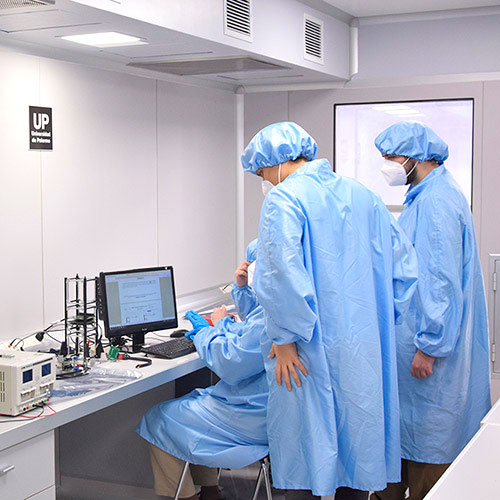
The technology being researched by the satellite aims to meet the communication needs of vast, remote areas far from urban centers, using low-power terrestrial devices.
The satellite must establish communications with small devices powered by small batteries, which lack large antennas and complex receivers to facilitate long-distance communication, such as with a base station in space. This necessitates placing all the technological complexity on the satellite, which must compensate for the simplicity of the devices on the ground. The large number of devices spread across vast coverage areas presents another challenge, increasing the complexity of processing and mitigating interference.
The need to deploy and adapt technologies for non-terrestrial networks, originally designed for terrestrial networks, requires extending and modifying current standards for cellular communications and various IoT communication variants. This introduces new challenges, such as synchronization, handoff between different satellites and between satellites and terrestrial networks, latency, signal attenuation, and others.
Stages of LABSAT IoT
In this stage, the teams from UP representing the fields of Telecommunications, Operations Programming, and Attitude Control are preparing the first mission-specific and control subsystems that will be used in space.
The initial prototypes of each satellite module are constructed as “Engineering Models”, allowing for testing, manipulation, and debugging in the Electronics and Communication Laboratory (LEC) at the School of Engineering of UP. Once the development cycle of each module is complete, its “Flight Model” is built and prepared for integration into the satellite at the Satellite Technology Laboratory (LTS) of UP.
Support structures, attitude control test structures, and shielding are being constructed at the Prototyping, Control, and Robotics Laboratory (LCPR) of UP.
Currently, most of the satellite modules are ready to begin integration into the satellite at the Satellite Technology Laboratory.
In parallel, the operations development teams are working on programming the flight computer, while the signal processing team is focused on optimizing the FPGAs and processing algorithms for handling communication signals across the various technologies and operating bands to be covered.
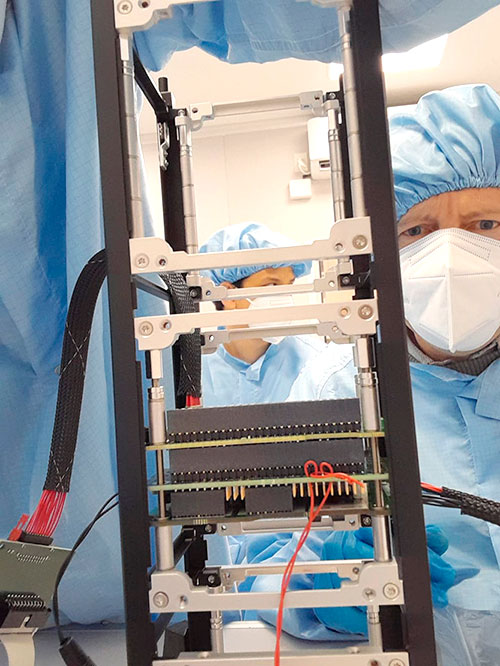
Researchers, Graduates, and UP Students Working on the Design, Development, and Ground Testing of the Satellite's Subsystems.
Opportunity and Stimulus
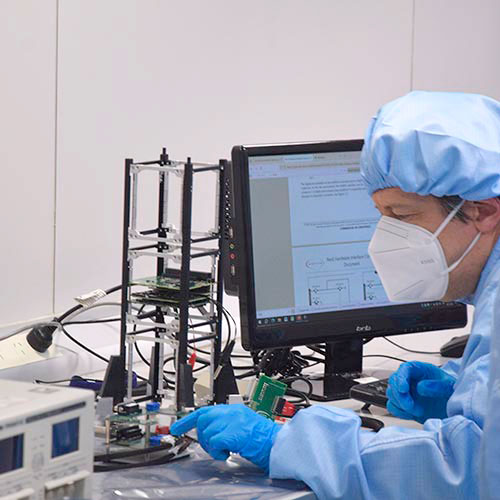
For students, graduates, and professors, this initiative represents a significant opportunity and encouragement as it connects them with cutting-edge technology and motivates them to engage with the transformative processes in telecommunications and the booming space industry in the country.
Currently, a global process is underway to develop standards that will govern the expansion of telecommunications services in the coming years. This project anticipates this process by developing, testing, and validating the technological alternatives and innovations necessary for these new services, generating development, jobs, and entrepreneurship.
New ventures in the New Space economy require risk investment and the development of technologies currently competing among many alternatives. The companies and technologies that emerge as leaders will come from technological initiatives like LABSAT that enable their deployment, testing, and provision as a service.
Among the services to be tested and deployed by LABSAT IoT are communications with millions of autonomous, generally very small objects spread across vast non-urban regions, which have energy and weight restrictions. It has already been learned that deploying terrestrial communication infrastructure in large non-urban areas, and even at sea, is economically unviable, and that deployment via low Earth orbit (LEO) satellites offers the best economic and technological option. However, there are no technologies that are clearly winning for achieving this deployment. Technological initiatives like LABSAT IoT will help clarify the future of the sector.
“At the School of Engineering at UP, we aim to grow our laboratories' capacity each year to develop and test new technologies in cutting-edge projects. This is why we are promoting the creation of a low-orbit satellite telecommunications laboratory and opening the orbital laboratory's services to other universities and institutions within the Argentine technology ecosystem”, explains engineer Alejandro Popovsky, Dean of the School of Engineering at UP and Director of the LABSAT IoT Project.
As stated in the project's mission, the objective of the satellite laboratory comprised of non-geostationary nanosatellites is initially to develop the capabilities to research and test technologies in the space environment directed toward Earth.
Alejandro Popovsky emphasized: “LABSAT IoT is much more than a technology integration project, especially in telecommunications, which represents the project’s 'mission.' We are working with technologies that are not standardized but are currently under discussion in standardization bodies around the world, in stages of testing and proof of concept, and in planning stages for future services. We must reach and surpass these technologies through the capabilities enabled by our LABSAT.”
“Many institutions are interested in participating in a space project, and they will be able to do so because our project is a space laboratory through which future engineers, entrepreneurs, and researchers in Argentina will be able to test telecommunications technologies. We will open the possibility for Argentine universities and ventures to access these capabilities”, concluded the Dean of the School of Engineering at UP.
Partnership
The project is being carried out in partnership between the University of Palermo (UP) and Fundetec (Foundation for the Development of Telecommunications, Electronics, and Communication), which is the foundation of Copitec (Professional Council of Telecommunications, Electronics, and Computing). The University of Palermo and COPITEC/FUNDETEC received support from the National Secretariat of Industry, Knowledge Economy, and Commercial Management to kick off the project in December 2021. The School of Engineering at UP is responsible for the engineering and construction of the satellite, while FUNDETEC handles the project’s administrative tasks.
The laboratory will provide access to the academic and research communities of these institutions, as well as to entrepreneurial ventures, which will promote the development of the space and telecommunications sectors. Among the institutions that are already affiliated and will be able to use the LABSAT IoT facilities for research projects are CITEDEF, LIA Aerospace, UTN FRBA, UNDAV, UNM, UNRN, Universidad Austral, UTN NQN, ICTE, AEROPAC, and UNDEF.
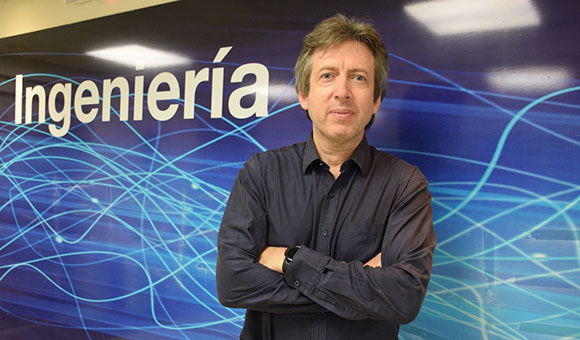
School of Engineering: Awards and Recognitions

1st Prize in the Software Industry 2018 for IT Talent Development

1st Prize in the Software Industry 2012 for Educational Quality and Innovation

Winner of the Balseiro Award 2009**
For the most significant university initiatives aimed at promoting scientific and technological collaboration

Frida Award 2020 from LACNIC
For the project “Congestion Algorithms for Latency Optimization.”
(**) The Science and Technology Forum for Production awarded the "Dr. José A. Balseiro" prize in the private university category.
 Whatsapp +54 9 11 38325424
Whatsapp +54 9 11 38325424







